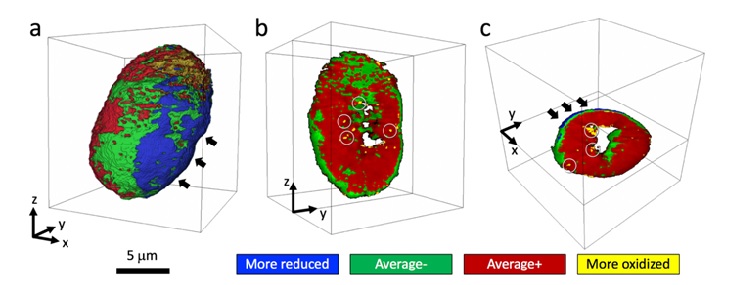The massive consumption of fossil energy and the associated environmental deterioration have led to global concern that calls for innovations in energy technologies. Energy storage is a vital component in this field because it could facilitate ground breaking changes in modern lifestyle by affecting how the energy is stored, transported and consumed. The deployment of lithium ion battery in electric vehicles (EVs) is a good example of this kind, which, however, puts stringent requirements on their rechargeable batteries, including high energy density, high power density, long cycle/calendar life and low cost.
Nickel-rich layered materials LiNi1-x-yMnxCoyO2 (NMC) are promising cathode candidates for high energy density lithium-ion battery systems. Unfortunately, they suffer from capacity fading upon cycling, in particular, when they are charged to high voltages, which is required to achieve the desired energy and power density. A research team led by Dr. Yijin Liu (SSRL), Dr. Xiao-Qing Yang, and Dr. Enyuan Hu (BNL) tackled this problem by perform synchrotron based x-ray spectroscopy, diffraction, and imaging experiments on the cathode materials that were subjected to high-voltage cycling. Although the bulk averaged experimental probes suggested that the material under investigation is rather robust under aggressive charging to high voltages, the machine-learning-assisted nano-resolution spectro-microscopy has facilitated the identification and visualization of undesired minority phases in the material. These minority phases are often overlooked because they are small in the total population and sparse in the spatial distribution. The machine learning methodology developed by this team helped the scientists search through a large amount of synchrotron imaging data and to identify the subset with “suspicious” spectroscopic fingerprints. They concluded that, while the chemical heterogeneity is ubiquitous, the particle surface and the isolated domains in the particle undergo different side reactions and cause the performance degradation in different mechanisms. Further comparison of particles with different initial morphology suggests that the hollow particles are more robust to cracking than the solid particles. They pointed out that morphological engineering could be an effective way of controlling the mechanical disintegration of the particles.
In addition to the valuable insights in the battery science, this study also highlights the importance of advanced computational approaches, which could help the scientists to extract scientifically important information from the big data efficiently and effectively. For future experiments at advanced x-ray facilities with even higher brightness and, thus, higher data rate, the computing effort is anticipated to play a more important role.

Figure 1. Three-dimensional distribution of different chemical phases within an NMC secondary particle that was cycled over a voltage window of 3-4.9 V. The different phases identified by a machine learning approach are color coded to the legend on the bottom. Their spectroscopic fingerprints and their respective spatial distribution suggest different degradation mechanisms.




